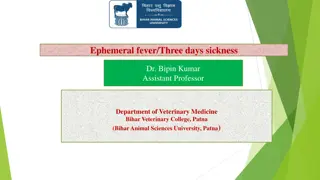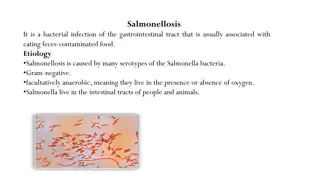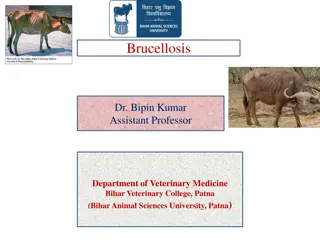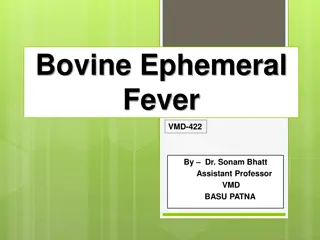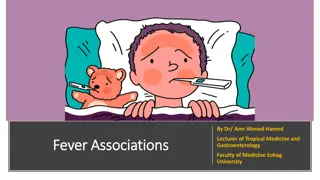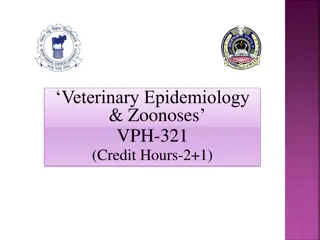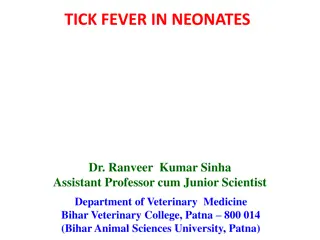Overview of Rift Valley Fever: Symptoms in Animals and Humans
Rift Valley Fever (RVF) is an acute viral hemorrhagic fever primarily affecting domesticated animals and humans. The disease is caused by the RVF virus transmitted through mosquito bites or contact with infected animal tissues. In animals, clinical signs vary with high mortality rates in young lambs, while adult sheep and cattle may show vague symptoms. In humans, RVF may present with mild flu-like symptoms such as fever, muscle pain, and headache. It is crucial to implement infection control measures to prevent the spread of the virus.
Download Presentation

Please find below an Image/Link to download the presentation.
The content on the website is provided AS IS for your information and personal use only. It may not be sold, licensed, or shared on other websites without obtaining consent from the author.If you encounter any issues during the download, it is possible that the publisher has removed the file from their server.
You are allowed to download the files provided on this website for personal or commercial use, subject to the condition that they are used lawfully. All files are the property of their respective owners.
The content on the website is provided AS IS for your information and personal use only. It may not be sold, licensed, or shared on other websites without obtaining consent from the author.
E N D
Presentation Transcript
Rift Valley fever (RVF) is an acute viral hemorrhagic fever that is most commonly seen in domesticated animals (such as cattle, buffalo, sheep, goats, and camels) and can cause illness in people. The disease is caused by Rift Valley Fever virus (RVFV), a member of the genus Phlebovirus in the order Bunyavirales. Some related Bunyavirales viruses can also cause illness in people, such as hantaviruses and Crimean-Congo hemorrhagic fever (CCHF) virus.
1- Several different species of mosquitoes are competent vectors for the RVF virus, and rises in incidence of RVF most commonly occur after periods of heavy rainfall which lead to an abundance of mosquitoes. 2- Competent mosquito vectors (Aedes, for example) transmit virus from infected animals to other animals (and to humans). 3- iatrogenically such as by reuse of needles between infected animals.
Humans are readily infected with RVFV via exposure to: 1- Tissues or fluids from infected animals and aborted fetuses 2- Aerosolized blood from infected animals during slaughter 3- Mosquito bites (considered less likely) Therefore, farmers, farm workers, slaughterhouse workers, and veterinarians are particularly at risk. 4- To date, no human-to-human transmission of RVF has been documented, and no transmission of RVF to health care workers has been reported when standard infection control precautions have been put in place. 5- There has been no evidence of human outbreaks of RVF in urban areas.
Clinical Findings of Rift Valley Fever in Animals Clinical signs of Rift Valley fever tend to be nonspecific, rendering it difficult to recognize individual cases. 1- The incubation period is 12 36 hours in lambs, and a biphasic fever of up to 108 F (42 C) may develop. 2-Mortality in young lambs is high (90% 100%), and animals usually die within 2 3 days. 3- Adult sheep are less susceptible, with 10% 30% mortality; the incubation period is 24 72 hours, and animals show a generalized febrile response, lethargy, hematemesis, hematochezia, and nasal discharge, although infection may also be inapparent. 4- Calves are less susceptible than lambs; Clinical signs are similar to those in sheep, but icterus is more common. Disease in adult cattle is often inapparent.
Clinical features in humans Mild form of RVF in humans The following are clinical features of the mild form of RVF in humans: 1- The incubation period (the interval from infection to onset of symptoms) for RVF varies from 2 to 6 days. 2- Those infected either experience no detectable symptoms or develop a mild form of the disease characterized by a feverish syndrome with sudden onset of flu-like fever, muscle pain, joint pain and headache. sensitivity to light, loss of appetite and vomiting; in these patients the disease, in its early stages, may be mistaken for meningitis. 3- The symptoms of RVF usually last from 4 to 7 days, after which time the immune response becomes detectable with the appearance of antibodies and the virus disappears from the blood.
Severe form of RVF in humans 1- Ocular form: In this form of the disease, the usual symptoms associated with the mild form of the disease are accompanied by retinal lesions. The onset of the lesions in the eyes is usually 1 to 3 weeks after appearance of the first symptoms. 2- Meningoencephalitis form: The onset of the meningoencephalitis form of the disease usually occurs 1 to 4 weeks after the first symptoms of RVF appear. Clinical features include intense headache, loss of memory, hallucinations, confusion, disorientation, vertigo, convulsions, lethargy and coma. 3- Haemorrhagic fever form: The symptoms of this form of the disease appear 2 4 days after the onset of illness, and begin with evidence of severe liver impairment, such as jaundice.
Diagnosis of Rift Valley Fever in Animals 1- Abortions and death associated with heavy rainfall and flooding 2- Characteristic histological lesions in liver specimens (necrotic hepatitis) 3- Immunohistochemistry, PCR assay, or viral isolation 4- Demonstration of seroconversion
Control and Prevention of Rift Valley Fever in Animals 1- Prediction may provide early warning 2- Vaccination of susceptible animals Once an outbreak of Rift Valley fever has started, any efforts to mitigate its course are usually futile. Control of vectors, movement of stock to high-lying areas, and confinement of stock in insect-proof stables are usually impractical, instituted too late, and of little value. Treatment of individual clinically affected animals should be symptomatic, and the high risk of zoonotic transmission to humans via tissues or fluids should be considered.
Presenter name Thank you Email address Website








